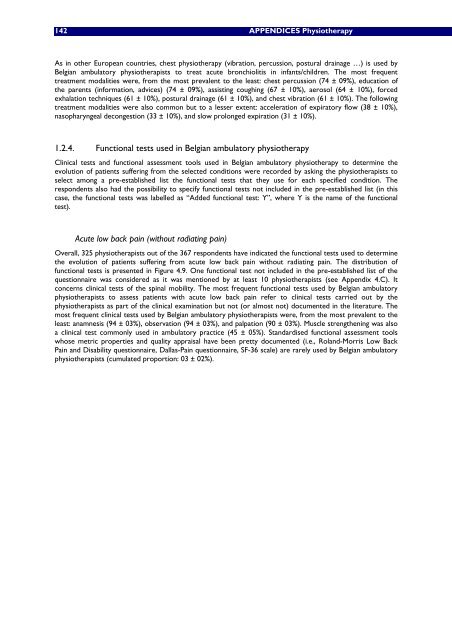Download the supplement (208 p.) - KCE
Download the supplement (208 p.) - KCE
Download the supplement (208 p.) - KCE
You also want an ePaper? Increase the reach of your titles
YUMPU automatically turns print PDFs into web optimized ePapers that Google loves.
142 APPENDICES Physio<strong>the</strong>rapy<br />
As in o<strong>the</strong>r European countries, chest physio<strong>the</strong>rapy (vibration, percussion, postural drainage ) is used by<br />
Belgian ambulatory physio<strong>the</strong>rapists to treat acute bronchiolitis in infants/children. The most frequent<br />
treatment modalities were, from <strong>the</strong> most prevalent to <strong>the</strong> least: chest percussion (74 ± 09%), education of<br />
<strong>the</strong> parents (information, advices) (74 ± 09%), assisting coughing (67 ± 10%), aerosol (64 ± 10%), forced<br />
exhalation techniques (61 ± 10%), postural drainage (61 ± 10%), and chest vibration (61 ± 10%). The following<br />
treatment modalities were also common but to a lesser extent: acceleration of expiratory flow (38 ± 10%),<br />
nasopharyngeal decongestion (33 ± 10%), and slow prolonged expiration (31 ± 10%).<br />
1.2.4. Functional tests used in Belgian ambulatory physio<strong>the</strong>rapy<br />
Clinical tests and functional assessment tools used in Belgian ambulatory physio<strong>the</strong>rapy to determine <strong>the</strong><br />
evolution of patients suffering from <strong>the</strong> selected conditions were recorded by asking <strong>the</strong> physio<strong>the</strong>rapists to<br />
select among a pre-established list <strong>the</strong> functional tests that <strong>the</strong>y use for each specified condition. The<br />
respondents also had <strong>the</strong> possibility to specify functional tests not included in <strong>the</strong> pre-established list (in this<br />
case, <strong>the</strong> functional tests was labelled as Added functional test: Y , where Y is <strong>the</strong> name of <strong>the</strong> functional<br />
test).<br />
Acute low back pain (without radiating pain)<br />
Overall, 325 physio<strong>the</strong>rapists out of <strong>the</strong> 367 respondents have indicated <strong>the</strong> functional tests used to determine<br />
<strong>the</strong> evolution of patients suffering from acute low back pain without radiating pain. The distribution of<br />
functional tests is presented in Figure 4.9. One functional test not included in <strong>the</strong> pre-established list of <strong>the</strong><br />
questionnaire was considered as it was mentioned by at least 10 physio<strong>the</strong>rapists (see Appendix 4.C). It<br />
concerns clinical tests of <strong>the</strong> spinal mobility. The most frequent functional tests used by Belgian ambulatory<br />
physio<strong>the</strong>rapists to assess patients with acute low back pain refer to clinical tests carried out by <strong>the</strong><br />
physio<strong>the</strong>rapists as part of <strong>the</strong> clinical examination but not (or almost not) documented in <strong>the</strong> literature. The<br />
most frequent clinical tests used by Belgian ambulatory physio<strong>the</strong>rapists were, from <strong>the</strong> most prevalent to <strong>the</strong><br />
least: anamnesis (94 ± 03%), observation (94 ± 03%), and palpation (90 ± 03%). Muscle streng<strong>the</strong>ning was also<br />
a clinical test commonly used in ambulatory practice (45 ± 05%). Standardised functional assessment tools<br />
whose metric properties and quality appraisal have been pretty documented (i.e., Roland-Morris Low Back<br />
Pain and Disability questionnaire, Dallas-Pain questionnaire, SF-36 scale) are rarely used by Belgian ambulatory<br />
physio<strong>the</strong>rapists (cumulated proportion: 03 ± 02%).
















